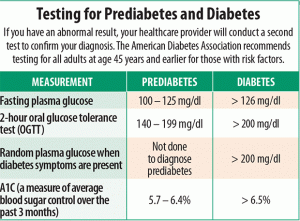How to Halt Prediabetes
You must know a lot of people with prediabetes. You might even have it yourself. Approximately one in three American adults has the symptomless disorder that puts them at risk for developing type 2 diabetes and heart disease. Only about 12% of people with prediabetes know they have it.
Prediabetes and Type 2 Diabetes Defined
You have prediabetes if your blood sugar level is higher than desirable, but lower than the criteria for diabetes (See Box: Testing for Prediabetes and Diabetes). Two things occur simultaneously in prediabetes and type 2 diabetes that lead to elevated blood sugar levels: various tissues of the body are resistant to the action of insulin and the body has lost some ability to produce its own insulin. Over time you may become even less able to produce insulin, leading you from prediabetes to type 2 diabetes.
Though both disorders are diagnosed by blood sugar levels, the effects extend throughout the body. Insulin resistance is also associated with fatty liver, blood vessel dysfunction, chronic low levels of inflammation, increased blood clotting, high blood pressure, and abnormal levels of cholesterol and triglycerides.

Stopping Prediabetes
People with prediabetes have about a 50% chance of developing type 2 diabetes over 5 to 10 years. Even without progressing to diabetes, prediabetes increases your chance of developing heart disease.
There are many risk factors for type 2 diabetes that you cannot control. Your risk is higher if you are male, have a family history of the disease, have had gestational diabetes, are of older age, have polycystic ovary syndrome, or if you are African American, Latino, Native American, Asian American or Pacific Islander. Having these risk factors though does not doom you to develop diabetes.
Fortunately, you can lower your chances of developing type 2 diabetes and heart disease by addressing your lifestyle habits and your body weight. Your greatest opportunity to prevent type 2 diabetes or dial back prediabetes is today. The changes you make can boost insulin sensitivity and protect your body’s ability to make insulin.
Drop a few pounds. Participants enrolled in the intensive lifestyle change group in the Diabetes Prevention Program (DPP) aimed to lose 7% of their body weight. During the 3-year study, they reduced their risk of developing diabetes by 58%. Even after 15 years, their risk was 27% lower. And there was a bonus for the heart: healthier blood pressure, cholesterol and triglyceride levels. If you have overweight or obesity, trim back calories and aim to lose 7 to 10% of your body weight (14 – 20 pounds for someone weighing 200 pounds).
Eat a plant slant diet. The American Diabetes Association (ADA) finds that a variety of wholesome eating patterns with emphasis on legumes (such as lentils and black beans), whole grains, nuts, fruits and vegetables are beneficial. Additionally, they recommend minimal intake of highly processed foods. Research links Mediterranean-style diets—which also focus on plant foods—to lower risks for type 2 diabetes, heart attack and stroke. A large meta-analysis of more than 100,000 participants from around the world found that individuals whose diets most resembled a Mediterranean style were 23% less likely to develop diabetes. Finally, the ADA reports that higher intakes of coffee, tea, yogurt, berries and nuts are associated with reduced risk of developing the disease.
Keep moving. Even without weight loss, physical activity improves insulin resistance. Each bout of exercise can boost insulin sensitivity for 2 to 48 hours. The ADA recommends engaging in at least 150 minutes of moderate-intensity physical activity, such as brisk walking, each week. Maintaining or building muscle with resistance training—such as using exercise bands or lifting weights—is also critical because muscle is where we store blood sugar after eating. Finally, reduce sitting. The ADA recommends breaking up periods of inactivity with at least 3 minutes of walking, leg lifts, toe raises or other light activity every 30 minutes to stimulate muscles.
Don’t smoke. If you do, see your healthcare provider for advice to quit. Smoking increases the risks for developing both type 2 diabetes and heart disease.
Get to bed on time. Aim to sleep 7 to 8 hours nightly. Getting regular shut-eye is good for our motivation, energy and focus. And sleeping too little seems to negatively affect body weight, blood sugar control and risks for type 2 diabetes and heart disease.
—Jill Weisenberger, MS, RDN, CDE
The post How to Halt Prediabetes appeared first on University Health News.
Read Original Article: How to Halt Prediabetes »
Powered by WPeMatico

